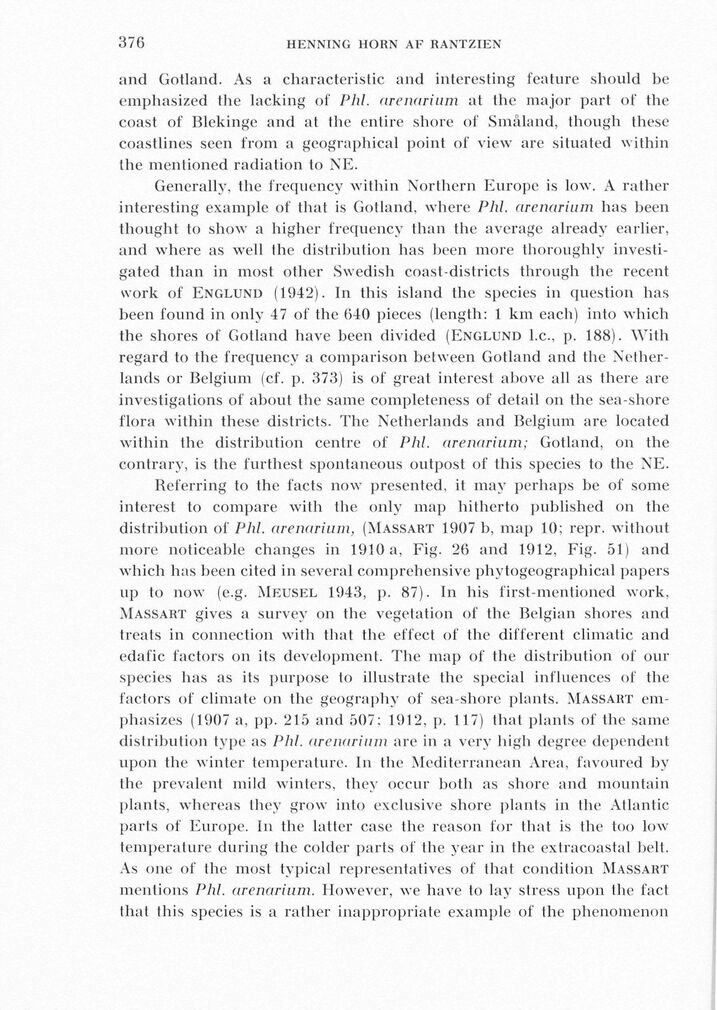
Full resolution (JPEG) - On this page / på denna sida - Sidor ...

<< prev. page << föreg. sida << >> nästa sida >> next page >>
Below is the raw OCR text
from the above scanned image.
Do you see an error? Proofread the page now!
Här nedan syns maskintolkade texten från faksimilbilden ovan.
Ser du något fel? Korrekturläs sidan nu!
This page has never been proofread. / Denna sida har aldrig korrekturlästs.
376
HENNING HORN AF RANTZIEN
and Gotland. As a characteristic and interesting feature should be
emphasized the lacking of Phl. arenarium at the major part of the
coast of Blekinge and at the entire shore of Småland, though these
coastlines seen from a geographical point of view are situated within
the mentioned radiation to NE.
Generally, the frequency within Northern Europé is low. A rather
interesting example of that is Gotland, where Phl. arenarium has been
thought to show a higher frequency than the average alreadv earlier,
and where as well the distribution has been möre thoroughly
investi-gated than in most other Swedish coast-districts through the recent
work of Englund (1942). In this island the species in question has
been found in only 47 of the 640 pieces (length: 1 km each) into which
the shores of Gotland have been divided (Englund I.e., p. 188). With
regard to the frequency a comparison between Gotland and the
Nether-lands or Belgium (cl’, p. 373) is of great interest above all as there are
investigations of about the same completeness of detail ön the sea-shore
flora within these districts. The Netherlands and Belgium are located
within the distribution centre of Phl. arenarium; Gotland, ön the
contrary, is the furthest spontaneous outpost of this species to the NE.
Referring to the facts now presented, it may perhaps be of some
interest to compare with the only map hitherto published ön the
distribution of Phl. arenarium, (Massart 1907 b, map 10; repr. without
möre noticeable changes in 1910 a, Fig. 26 and 1912, Fig. 51) and
which has been cited in several comprehensive phytogeographical papers
up to now (e.g. Mf:usel 1943, p. 87). In his first-mentioned work,
Massart gives a survev ön the vegetation of the Belgian shores and
treats in connection with that the effect of the different climatic and
edafic factors ön its development. The map of the distribution of our
species has as ils purpose to illustrate the special influences of the
factors of cl i mat c ön the geographv of sea-shore plants. Massart
em-phasizes (1907 a, pp. 215 and 507: 1912, p. 117) that plants of the same
distribution type as Phl. arenarium are in a verv high degree dependent
upon the winter tempera Iure. In the Mediterranean Area, favoured by
the prevalent mild winters, they occur botli as shore and mountain
plants, whereas they grow into exclusive shore plants in the Atlantic
parts of Europé. In the latter case the reason for that is the too low
temperature during the colder parts of the vear in the extracoastal hell.
As one of the most typical representatives of that condition Massart
mentions Phl. arenarium. However, we have lo lay stress upon the fact
that this species is a rather inappropriate example of the phenomenon
<< prev. page << föreg. sida << >> nästa sida >> next page >>